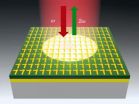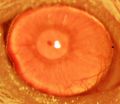(Press-News.org) PHOENIX, Ariz. — July 2, 2014 — Lung cancer patients could receive more precise treatment, and their progress could be better tracked, using a new high-tech method of non-invasive medical imaging analysis, according to a study published today by the journal PLOS ONE.
Genetic changes increasingly are recognized as driving cancer development. But obtaining evidence of these changes usually requires a biopsy, which can be problematic for sensitive regions of the body such as the lungs.
Based on a review of 48 patients with non-small cell lung cancer (NSCLC), the study found that by scanning their tumor cells using "quantitative computed tomography based texture analysis" (QTA), researchers could determine — with nearly 90 percent accuracy — whether the patient's tumor had a cancer-causing K-ras gene mutation.
The study was led by investigators at the Translational Genomics Research Institute (TGen), the Virginia G. Piper Cancer Center at Scottsdale Healthcare, and Cancer Treatment Centers of America (CTCA).
NSCLC represents more than 85 percent of all lung cancers, which will kill an estimated 159,000 Americans this year, making it the leading cause of cancer-related death. It has a five-year survival rate less than 10 percent.
QTA was shown to be an accurate — and non-invasive — alternative to surgical biopsy and other invasive means of collecting and analyzing biological samples, the study said. This method of making genomic distinctions may help physicians determine the best type of treatment to administer to each patient.
"The ability to rapidly and non-invasively characterize NSCLC tumors would be a great asset to clinical oncologists," said Dr. Glen Weiss, the study's lead author, Director of Clinical Research and Medical Oncologist at Cancer Treatment Centers of America's Western Regional Medical Center in Phoenix, and a Clinical Associate Professor in TGen's Cancer and Cell Biology Division.
"QTA applied to molecularly defined NSCLC cases may have a broader application to precision medicine by offering a non-invasive way of identifying the best therapies for each patient," said Dr. Weiss.
Dr. Ronald Korn, Medical Director of Scottsdale Healthcare's Virginia G. Piper Cancer Center and the study's senior author, described QTA as a substantial step forward in the use of medical imaging: "Non-invasive characterization of a tumor's molecular features could enhance treatment management. Non-invasive QTA can differentiate the presence of K-ras mutation from pan-wildtype NSCLC."
Dr. Korn also is CEO and Medical Director of Imaging Endpoints, a leading imaging core lab that provides centralized image handling and advanced image interpretations for clinical trials. Through Scottsdale Healthcare Research Institute, and in collaboration with Imaging Endpoints Core Lab, this team has developed one of the only global radiology research laboratories that specializes in rapid detection and assessment of response (also known as the RADAR program).
"Although, more studies are needed to move our RADAR program forward towards routine medical use, our core lab remains focused upon characterizing tumors non-invasively through imaging and then using these technologies to help determine, as soon as possible, whether cancer treatments are working, sometimes within days to weeks after the start of therapy" said Dr. Korn.
Dr. Weiss said future studies using QTA also could help identify other genomic sub-types of NSCLC.
INFORMATION:
This study, Noninvasive Image Texture Analysis Differentiates K-ras Mutation
from Pan-Wildtype NSCLC and is Prognostic, was supported by the TGen Foundation, the Scottsdale Healthcare Foundation, the Flinn Foundation, and the United Kingdom Department of Health. Sequenom Inc. provided the LungCarta Panel test analysis.
About the Virginia G. Piper Cancer Center at Scottsdale Healthcare
The Virginia G. Piper Cancer Center at Scottsdale Healthcare in Scottsdale, Ariz. offers comprehensive cancer treatment and research through clinical trials, diagnosis, treatment, prevention and support services in collaboration with leading scientific researchers and community oncologists. The Virginia G. Piper Cancer Center at Scottsdale Healthcare, Scottsdale Healthcare Research Institute, Scottsdale Healthcare Osborn Medical Center, Scottsdale Healthcare Shea Medical Center and Scottsdale Healthcare Thompson Peak Hospital and related entities are part of the non-profit Scottsdale Lincoln Health Network. For more information, visit: http://www.shc.org.
Press Contact:
Kaitlan Schick
Virginia G. Piper Cancer Center at Scottsdale Healthcare
480-323-1384
kaitlan.schick@jcl.com
About Cancer Treatment Centers of America®
Cancer Treatment Centers of America, Inc. (CTCA) is a national network of five hospitals that focus on the treatment of complex and advanced-stage cancer. CTCA offers a comprehensive, fully integrative approach to cancer treatment and serves patients from all 50 states at facilities located in Atlanta, Chicago, Philadelphia, Phoenix and Tulsa. Known for delivering the Mother Standard® of care and Patient Empowerment Medicine®, CTCA provides patients with information about cancer and their treatment options so they can control their treatment decisions. For more information about CTCA, visit http://www.cancercenter.com.
Press Contact:
Nicole McTheny
Director, Public Affairs
Cancer Treatment Centers of America®
14200 W. Celebrate Life Way, Goodyear, AZ 85338
O: (623) 207-3983
C: (602) 339-1569
Nicole.McTheny@ctca-hope.com
About Imaging Endpoints
Imaging Endpoints is a full-service imaging contract research organization providing services to the pharmaceutical, biotech and medical device industries to accelerate their national and international clinical trials. Extensive expertise in imaging allows Imaging Endpoints to perform real-time qualitative and quantitative assessments of both anatomic and physiologic/metabolic imaging modalities in order to better probe the effectiveness of new therapeutics. In addition to its expertise in oncology, Imaging Endpoints has expertise in neurological, musculoskeletal and cardiovascular radiologic sciences, and experience in all phases of clinical trials from preclinical through Phase III and post-market studies. QTA is exclusively available through Imaging Endpoints Core Lab and has been used in analysis of solid tumors such as colorectal cancers, pancreas cancers, lung cancers, prostate cancers and breast cancers. For more information about Imaging Endpoints' suite of services, visit http://www.imagingendpoints.com.
About TGen
Translational Genomics Research Institute (TGen) is a Phoenix, Arizona-based non-profit organization dedicated to conducting groundbreaking research with life changing results. TGen is focused on helping patients with cancer, neurological disorders and diabetes, through cutting edge translational research (the process of rapidly moving research towards patient benefit). TGen physicians and scientists work to unravel the genetic components of both common and rare complex diseases in adults and children. Working with collaborators in the scientific and medical communities literally worldwide, TGen makes a substantial contribution to help our patients through efficiency and effectiveness of the translational process. For more information, visit: http://www.tgen.org.
Press Contact:
Steve Yozwiak
TGen Senior Science Writer
602-343-8704
syozwiak@tgen.org
Noninvasive advanced image analysis could lead to better patient care
Lung cancer patients could especially benefit from new 'QTA' technique
2014-07-02
ELSE PRESS RELEASES FROM THIS DATE:
Researchers invent 'meta mirror' to help advance nonlinear optical systems
2014-07-02
Researchers at the Cockrell School of Engineering at The University of Texas at Austin have created a new nonlinear metasurface, or meta mirror, that could one day enable the miniaturization of laser systems.
The invention, called a "nonlinear mirror" by the researchers, could help advance nonlinear laser systems that are used for chemical sensing, explosives detection, biomedical research and potentially many other applications. The researchers' study will be published in the July 3 issue of Nature.
The metamaterials were created with nonlinear optical response ...
A million times better
2014-07-02
This news release is available in German.
Lasers have a fixed place in many fields of application. Yet, there are still wavelengths for which either no systems exist, or at best only large and expensive ones. On the other hand remote sensing and medical applications call for compact laser systems, for example with wavelengths from the near infrared to the Terahertz region.
A team of researchers at the Technische Universitaet Muenchen (Germany) and the University of Texas Austin (USA) has now developed a 400 nanometer thick nonlinear mirror that reflects frequency-doubled ...
Scientists can now screen for stem cells that enhance corneal regrowth
2014-07-02
A Boston-based scientific collaborative, led by Harvard Stem Cell Institute (HSCI) researchers, has discovered a way to collect the best cell type for regenerating a damaged cornea—the clear membrane that covers the pupil and directs light into the back of the eye. The investigators report in the journal Nature that purified human stem cells can be used to improve long-term vision in mice. The team is now pursuing FDA-approval for the technique before moving on to patient clinical trials.
The study, lead by co-senior investigators Natasha Frank, MD, and Markus Frank, ...
Die-offs of band-tailed pigeons connected to newly discovered parasite
2014-07-02
A new pathogen has been discovered by scientists investigating major
die-offs of pigeons native to North America, according to studies led
by the University of California, Davis, and the California Department
of Fish and Wildlife.
Scientists were able to implicate this new parasite, along with the
ancient parasite Trichomonas gallinae, in the recent deaths of
thousands of Pacific Coast band-tailed pigeons. The die-offs occurred
during multiple epidemics in California's Central Coast and Sierra
Nevada mountain ranges. Scientists named the new pathogen Trichomonas
stableri.
Avian ...
Computer-automated, time-lapse embryo photography may increase success of IVF
2014-07-02
PHILADELPHIA - Using computer-automated, time‐lapse photography of embryos in the laboratory during in-vitro fertilization may improve embryo selection, potentially increasing the chances of pregnancy among women undergoing the procedure, according to new research from the Perelman School of Medicine at the University of Pennsylvania and five other fertility centers. Results of the study were presented this week at the 30th annual European Society of Human Reproduction and Embryology (ESHRE) meeting in Munich, Germany.
The researchers at Penn and their collaborators ...
Novel intravaginal ring shows promise for HIV prevention
2014-07-02
A novel intravaginal ring implanted with anti-retroviral drug tablets, or pods, demonstrated sustained and controlled drug release and safety over 28 days, according to a paper published ahead of print in Antimicrobial Agents and Chemotherapy. The ring, designed to prevent transmission of HIV, was tested in pig-tailed macaque monkeys, and is engineered to be inexpensive, all the better for use in developing countries, says corresponding author Marc Baum.
One of the two drug combinations tested in the ring had been shown in three clinical trials to prevent HIV—some of ...
Veterans with muscle injuries and mental health conditions more likely to end service
2014-07-02
ANN ARBOR, Mich. — Sixty percent of U.S. Army soldiers who were unable to return to a military career after an Iraq deployment couldn't do so because of a muscle, bone or joint injury and nearly half had a mental health diagnosis, according to a new study from the University of Michigan and VA Ann Arbor Healthcare System.
Lower rank, which indicated socioeconomic status, was also a predictor of poor health outcomes among service members, according to the research that appears in the Journal of Bone and Joint Surgery and was led by a former Army Major who served in ...
Japanese gold leaf artists worked on a nanoscale
2014-07-02
Ancient Japanese gold leaf artists were truly masters of their craft. An analysis of six ancient Namban paper screens show that these artifacts are gilded with gold leaf that was hand-beaten to the nanometer scale. Study leader Sofia Pessanha of the Atomic Physics Center of the University of Lisbon in Portugal believes that the X-ray fluorescence technique her team used in the analysis could also be used to date other artworks without causing any damage to them. The results are published in Springer's journal Applied Physics A: Materials Science & Processing.
Gold leaf ...
A tale of a tail -- Kangaroos' powerful 'fifth leg'
2014-07-02
A Simon Fraser University study on how kangaroos use their tails as a 'fifth' leg is providing new insight into the diversity of biological movement, and specific insight into why we walk the way we do.
Published today in the Royal Society journal Biology Letters, the study, led by professor Max Donelan of SFU's Locomotion Laboratory, found kangaroos, commonly viewed as hoppers, move with a "pentapedal" gait, planting their tails on the ground in combination with their front and hind legs.
"We measured the forces the tail exerts on the ground and calculated the mechanical ...
Stem cell type resists chemotherapy drug
2014-07-02
PROVIDENCE, R.I. [Brown University] — A new study shows that adipose-derived human stem cells, which can become vital tissues such as bone, may be highly resistant to the common chemotherapy drug methotrexate (MTX). The preliminary finding from lab testing may prove significant because MTX causes bone tissue damage in many patients.
MTX is used to treat cancers including acute lymphoblastic leukemia, the most common form of childhood cancer. A major side effect of the therapy, however, is a loss of bone mineral density. Other bone building stem cells, such as bone marrow ...
LAST 30 PRESS RELEASES:
Scalable and healable gradient textiles for multi‑scenario radiative cooling via bicomponent blow spinning
Research shows informed traders never let a good climate crisis go to waste
Intelligent XGBoost framework enhances asphalt pavement skid resistance assessment
Dual-function biomaterials for postoperative osteosarcoma: Tumor suppression and bone regeneration
New framework reveals where transport emissions concentrate in Singapore
NTP-enhanced lattice oxygen activation in Ce-Co catalysts for low-temperature soot combustion
Synergistic interface engineering in Cu-Zn-Ce catalysts for efficient CO2 hydrogenation to methanol
COVID-19 leaves a lasting mark on the human brain
Scientists use ultrasound to soften and treat cancer tumors without damaging healthy tissue
Community swimming program for Black youth boosts skills, sense of belonging, study finds
Specific depressive symptoms in midlife linked to increased dementia risk
An ‘illuminating’ design sheds light on cholesterol
Who is more likely to get long COVID?
Study showcases resilience and rapid growth of “living rocks”
Naval Research Lab diver earns Office of Naval Research 2025 Sailor of the Year
New Mayo-led study establishes practical definition for rapidly progressive dementia
Fossil fuel industry’s “climate false solutions” reinforce its power and aggravate environmental injustice
Researchers reveal bias in a widely used measure of algorithm performance
Alcohol causes cancer. A study from IOCB Prague confirms damage to DNA and shows how cells defend against it
Hidden viruses in wastewater treatment may shape public health risks, study finds
Unlock the power of nature: how biomass can transform climate mitigation
Biochar reshapes hidden soil microbes that capture carbon dioxide in farmland
Reducing saturated fat intake shows mortality benefit, but only in high-risk individuals
Manta rays create mobile ecosystems, study finds
Study: Mixed results in using lipoic acid to treat progressive multiple sclerosis
Norbert Holtkamp appointed director of Fermi National Accelerator Laboratory
New agentic AI platform accelerates advanced optics design
Biologists discover neurons use physical signals — not electricity — to stabilize communication
Researchers discover that a hormone can access the brain by hitchhiking
University of Oklahoma researcher awarded funding to pursue AI-powered material design
[Press-News.org] Noninvasive advanced image analysis could lead to better patient careLung cancer patients could especially benefit from new 'QTA' technique




